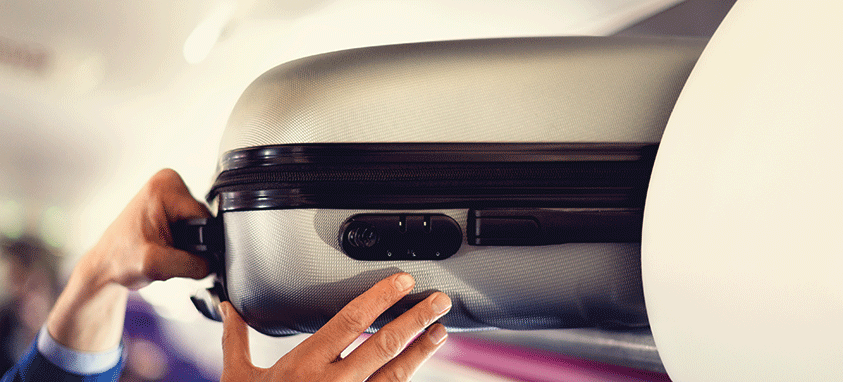What to be aware of when buying it and bringing it aboard your flight
Meeting professionals making plans to attend GMID worldwide events faced one common issue: what luggage to bring along. Extra charges for checked luggage have elevated the importance of carry-ons for business travelers, and resulted in new variations hitting the market, including smart luggage. Choosing the right luggage has become a challenge, but these tips can make the task much easier.
Selecting Your Piece
Since carry-on luggage stays with you, it doesn’t suffer some of the abuse experienced by checked luggage, such as being thrown or battered by airline handlers. It does need to be sturdy enough to last, however, so it’s best to pay for quality—well-manufactured hard-shell cases or strong, soft nylon cases.
Contrary to popular belief, hard-shell luggage isn’t always more durable than softer cases: Quality is the key for durability. Hard cases provide extra protection, but they are commonly heavier, and may have limited internal space due to the size of the shell. Soft bags are generally lighter, more flexible and expandable.
When it went on the market, smart luggage seemed like a godsend—and it still is, though not aboard planes. It generally costs more than regular luggage, but offers such high-tech features as power banks to charge devices, GPS tracking, electronic baggage tags and TSA-approved locks. But several domestic airlines—including Delta, American, Alaska and Hawaiian—and International Air Transport Association subsequently banned smart luggage (unless the lithium-ion battery in the luggage can be removed) because the batteries can potentially cause fires and explosions in cabins.
Some types of smart luggage, such as those made by Away and Raden, have removable battery packs and can still serve as carry-on pieces (the battery pack must be removed if you plan to check the suitcase).
Another carry-on option for travelers is backpacks, which have plenty of compartments for travel accessories and allow you to keep your hands free.
Some companies make bags shaped like a suitcase, but feature backpack straps. The rectangular shape provides additional space, but not as much support as a traditional backpack. Another option is a backpack on wheels, which comes with backpack straps that can be hidden when you’re not wearing it, and a harder, flatter surface than a traditional backpack.
Wheels, Handles and Compartments
The number of wheels is also an important consideration. Standard, two-wheeled luggage is perfectly suitable for many people, but four-wheel and eight-wheel designs also are available. And spinner wheels—which allow you to wheel your case not only forward and backward, but also sideways—are particularly useful in situations such as pushing luggage down a busy airplane aisle where space is limited.
Handles are definitely one of the most underrated components of luggage. A poorly built handle may break, snap or come out of its housing, making the luggage very difficult to transport. A sturdy, telescopic handle made of steel is ideal; a key indicator of a quality handle is if it has double stitching, paired with metal rivets for extra reinforcement. Cases often come with extendable handles that collapse into the body of the luggage when not being used. Backpacks must have strong, durable and flexible handles.
Business travelers often need room for laptops and other essential items. So, it’s important to have plenty of compartments in your luggage.
Bringing It Aboard
U.S. airlines not only have strict rules about the amount of carry-on luggage that can be brought aboard, but also limit the size of the items. If you have too many items, or your luggage is too large or heavy, it will need to be checked in. Generally, U.S. airlines allow one small purse, laptop bag or other small bag, as well as a bag measuring no more that 22-by-14-by-9 inches, but policies vary and there is no international airline standard. Most airlines include the wheels and handle when measuring the size of a suitcase.
Typically, carry-on luggage cannot weigh more than 40 pounds, including the weight of the bag itself. So, the weight of a suitcase or backpack when it’s empty is an important consideration if you’re concerned about an airline’s weight limitation. If you have doubts about the weight of your packed bag, it’s best to weigh it before you leave home. Carry-on luggage is kept in overhead lockers, so if bags are too heavy, they create a safety risk.
Laptops typically need to be individually scanned during security checks and often are used during flights. So, they need to be easily accessible. Passengers often pack them in a carrying case for protection, but some cabin storage bins provide well-padded laptop compartments. Check with your airline to see if a laptop case is within baggage limitations.
Key Takeaways
- Finding luggage that fits your own particular needs is the most essential thing to consider when purchasing carry-on luggage.
- Quality and convenience are vitally important.
- Hard-shell luggage isn’t always more durable than softer cases: Quality is the key for durability.
- Smart luggage is allowable as a carry-on on many U.S. airlines, but the battery must be removable.
- Backpacks are a good option for travelers because they free up your hands and are more flexible than suitcases, but they cause physical strain to some people.
- If you have concerns about the size and weight of your carry-on luggage, always ask your airline in advance.




